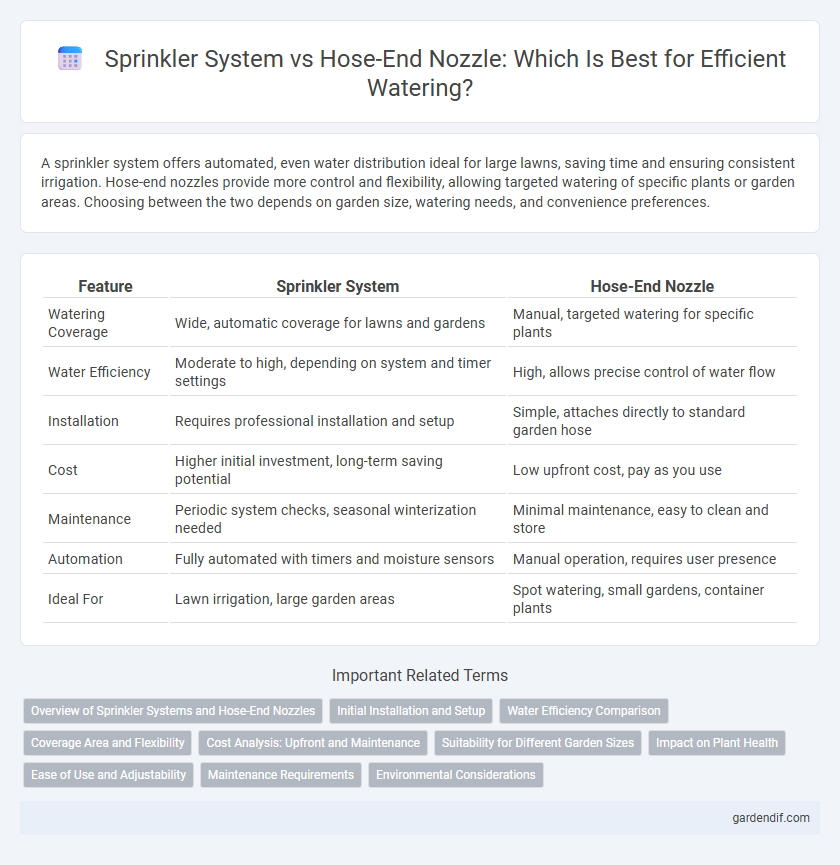
Sprinkler system vs Hose-end nozzle Illustration
A sprinkler system offers automated, even water distribution ideal for large lawns, saving time and ensuring consistent irrigation. Hose-end nozzles provide more control and flexibility, allowing targeted watering of specific plants or garden areas. Choosing between the two depends on garden size, watering needs, and convenience preferences.
Table of Comparison
| Feature | Sprinkler System | Hose-End Nozzle |
|---|---|---|
| Watering Coverage | Wide, automatic coverage for lawns and gardens | Manual, targeted watering for specific plants |
| Water Efficiency | Moderate to high, depending on system and timer settings | High, allows precise control of water flow |
| Installation | Requires professional installation and setup | Simple, attaches directly to standard garden hose |
| Cost | Higher initial investment, long-term saving potential | Low upfront cost, pay as you use |
| Maintenance | Periodic system checks, seasonal winterization needed | Minimal maintenance, easy to clean and store |
| Automation | Fully automated with timers and moisture sensors | Manual operation, requires user presence |
| Ideal For | Lawn irrigation, large garden areas | Spot watering, small gardens, container plants |
Overview of Sprinkler Systems and Hose-End Nozzles
Sprinkler systems provide automated and consistent watering by distributing water evenly across large areas, ideal for lawns and gardens, while hose-end nozzles offer manual control with adjustable spray patterns suited for targeted watering tasks. Sprinkler systems can be programmed for specific schedules, optimizing water usage and promoting plant health, whereas hose-end nozzles require manual operation but deliver flexibility for various watering needs. Both tools serve distinct purposes in irrigation, making selection dependent on garden size, plant types, and user preference for automation or manual control.
Initial Installation and Setup
Installing a sprinkler system involves laying underground pipes, connecting to the main water supply, and programming timers for automated watering, which requires more time and professional expertise compared to using a hose-end nozzle. Hose-end nozzles offer a straightforward setup by attaching directly to an existing garden hose, requiring minimal tools and no permanent alterations to the watering area. The higher initial costs and complexity of sprinkler systems are balanced by automated efficiency, while hose-end nozzles provide flexibility and ease of use for immediate setup.
Water Efficiency Comparison
Sprinkler systems distribute water evenly across large areas using automated timers and adjustable heads, optimizing water usage by targeting specific zones and reducing runoff. Hose-end nozzles require manual operation, allowing precise control over water flow and duration, which can minimize waste during spot watering. Overall, sprinkler systems enhance efficiency in landscape irrigation, while hose-end nozzles offer better water conservation for smaller, focused watering tasks.
Coverage Area and Flexibility
Sprinkler systems offer extensive coverage areas ideal for large lawns, providing uniform water distribution with adjustable spray patterns. Hose-end nozzles deliver targeted watering, maximizing flexibility for intricate garden layouts and spot treatments. Choosing between the two depends on the landscape size and the precision required for efficient water use.
Cost Analysis: Upfront and Maintenance
Sprinkler systems demand a higher upfront investment, typically ranging from $1,000 to $2,500 for installation, while hose-end nozzles usually cost between $10 and $50. Maintenance expenses for sprinkler systems can include annual inspections, repairs, and seasonal adjustments, potentially totaling $100 to $300 per year, in contrast to hose-end nozzles which require minimal upkeep. Choosing between these watering tools hinges on budget constraints and long-term maintenance considerations.
Suitability for Different Garden Sizes
Sprinkler systems are ideal for large gardens as they provide even water distribution over extensive areas, reducing manual effort and ensuring consistent irrigation. Hose-end nozzles are better suited for small to medium-sized gardens, allowing precise control and targeted watering for specific plants or flower beds. Choosing between these options depends on garden size, water pressure availability, and desired convenience.
Impact on Plant Health
Sprinkler systems provide even water distribution, promoting consistent soil moisture that supports healthy root development and reduces plant stress. Hose-end nozzles allow for targeted watering, which can prevent overwatering and minimize disease risk by keeping foliage drier. Choosing the appropriate watering method depends on plant type and garden size to optimize hydration and overall plant health.
Ease of Use and Adjustability
A sprinkler system offers automated watering with programmable timers, providing consistent coverage and hands-free convenience while adjusting spray patterns and durations via digital controls. Hose-end nozzles require manual operation, allowing immediate, tactile control over water pressure and spray type but demand active involvement for timing and coverage management. Both tools vary in ease of use and adjustability, with sprinklers excelling in automation and hose-end nozzles offering more direct, on-the-spot customization.
Maintenance Requirements
Sprinkler systems require regular inspection of sprinkler heads, valves, and pipes to prevent clogs and leaks, typically every few months. Hose-end nozzles demand less frequent maintenance, primarily involving cleaning the nozzle and checking for hose wear, which can be done seasonally. Proper upkeep of both ensures efficient water distribution and prolongs the lifespan of the watering equipment.
Environmental Considerations
Sprinkler systems distribute water more evenly and efficiently, reducing runoff and water waste compared to hose-end nozzles that often lead to overwatering and soil erosion. Using programmable sprinkler timers optimizes watering schedules to match plant needs and weather conditions, conserving water resources. Hose-end nozzles lack precision, increasing the risk of overwatering and higher water consumption, which can negatively impact local ecosystems and groundwater levels.
Sprinkler system vs Hose-end nozzle Infographic

 gardendif.com
gardendif.com